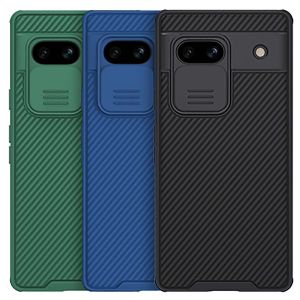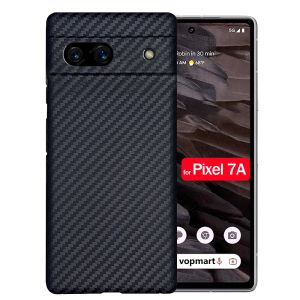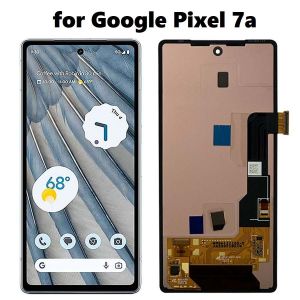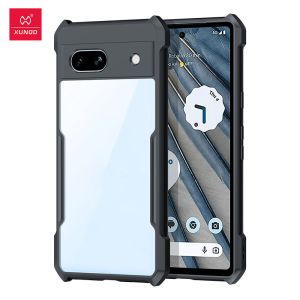1. Introduction
The latest member in the Google Pixel series is the new Pixel 7a, which is also part of the company's more accessible a-series of devices. Starting at $499, the Pixel 7a shares the spot with the Pixel 4a 5G as the most expensive a-series Pixel yet and is only $100 less than the Pixel 7.
Suddenly, then, the cheaper a-series phone doesn't seem all that cheap anymore. After all, why not spend the $100 extra if you are getting a better phone with the Pixel 7? But that's the conundrum here, as things aren't as clear-cut as you might think. The question isn't why wouldn't you spend extra for the Pixel 7. The question is, why would you?
Google Pixel 7a specs at a glance:
Body: 152.0x72.9x9.0mm, 194g; Glass front (Gorilla Glass 3), aluminum frame, plastic back; IP67 dust/water resistant (up to 1m for 30 min).
Display: 6.10" OLED, HDR, 90Hz, 1080x2400px resolution, 20:9 aspect ratio, 429ppi; Always-on display.
Chipset: Google Tensor G2 (5 nm): Octa-core (2x2.85 GHz Cortex-X1 & 2x2.35 GHz Cortex-A78 & 4x1.80 GHz Cortex-A55); Mali-G710 MP7.
Memory: 128GB 8GB RAM; UFS 3.1.
OS/Software: Android 13.
Rear camera: Wide (main): 64 MP, f/1.9, 26mm, 1/1.73", 0.8µm, Dual Pixel PDAF, OIS; Wide (main): 13 MP, f/2.2, 120˚, 1.12µm.
Front camera: 13 MP, f/2.2, 20mm (ultrawide), 1.12µm.
Video capture: Rear camera: 4K@30/60fps, 1080p@30/60/120/240fps; gyro-EIS, OIS; Front camera: 4K@30fps, 1080p@30fps.
Battery: 4385mAh; 20W wired, PD3.0, 18W wireless.
Connectivity: 5G; eSIM; Wi-Fi 6e; BT 5.3; NFC.
Misc: Fingerprint reader (under display, optical); stereo speakers.
You see, the Pixel 7a is about as close to the Pixel 7 as an a-series phone has ever gotten. Looking through the spec sheet, both phones have a surprising number of similarities. Both have a similar resolution display refreshing at 90Hz. Both have the exact same Tensor G2 chip inside and very similarly sized batteries. The Pixel 7a even adds wireless charging, something that has been missing on a-series phones in the past.
The differences then come down to the camera configuration and the display size. The camera figures all boast of a higher megapixel count on the Pixel 7a but we know that rarely amounts to anything. And the display is smaller, which means the phone itself is also smaller. Not necessarily a bad thing.
So it's an interesting matchup then and the more expensive Pixel 7 will have to fight harder than its predecessor to justify its existence. Let's see how the Pixel 7a performs.
Unboxing
The Pixel 7a ships in extremely minimal packaging that is barely bigger than the phone itself. Aside from the phone, all you get in the box is a USB-C charging and data cable as well as a USB-C male to USB-A female adapter.
The somewhat barebones packaging is a good way to save cost and the environment but buyers in this segment are often looking for more value and it doesn't help Google's case that most of its competitors are offering at least a charger in the box, with many also providing a case.
2. Design, display, charging, speakers
Design
The Pixel 7a looks visually identical to the Pixel 7. Both phones have a flat front display with sizable bezels around them, curved sides, and the same large camera bar at the back. Like the more expensive Pixel 7 models, the Pixel 7a loses some of the character of its predecessor, as the back is no longer two-tone and the camera bar lacks that distinctive visor look.
Google Pixel 7a hands-on review
The main difference between the Pixel 7a and the Pixel 7 is the size. Due to the smaller display, the Pixel 7a is smaller by a few millimeters. This makes the phone feel noticeably more manageable in hand as it is much easier to hold and carry and you can also access more of the display with your thumb without stretching. The camera bar on the back is also slimmer and doesn't stick out as much.
The other difference is the choice of materials. The Pixel 7a still uses aluminum for the frame and the camera bar but the two are no longer cut out of the same piece of metal. Also, the back cover is plastic and not glass. These changes are honestly quite difficult to notice and don't really make the phone look and feel particularly worse than the more expensive model.
Getting back to the bezels, they really are quite chunky and distracting on the Pixel 7a and even thicker than they were on the Pixel 7. On their own, they may not be larger than those found on other phones without a curved display but since the display on the Pixel 7a is relatively small, the bezels seem much larger in perspective. The centrally located front camera can also detract from the content you are watching.
The right side of the phone has the physical switches. Like on the more expensive models, the buttons on the Pixel 7a are rather stiff but due to the size of the device they are always within easy reach.
Like the Pixel 6a, the Pixel 7a is IP67 rated for dust and water resistance. This is something that is usually lacking on the cheaper phones and while the Pixel 7a isn't as affordable, at least you can have peace of mind while using the phone in less-than-ideal conditions.
Display
The Pixel 7a has a 6.1-inch OLED display with a 2400 x 1080 resolution and 90Hz refresh rate. The display has similar specifications to the more expensive Pixel 7 aside from being 0.2 inches smaller.
The display on the Pixel 7a may be on the smaller side but it's sharp and mostly color accurate, at least on the Natural preset. The display gets sufficiently bright with the manual slider and can get even brighter in Auto mode under bright light. The display will also adjust its contrast to improve legibility under sunlight.
Like all OLED panels, you also get great contrast and motion performance. There is some color fringing when viewed off-axis but it's nominal and only noticeable on brighter-colored content or when not using dark mode.
The 90Hz refresh rate on the Pixel 7a is a huge bump up from the 60Hz on all previous a-series phones. Unfortunately, in that time, most of the competition has now moved on to 120Hz, even on much cheaper models. So while it's definitely an improvement, at this point we expect higher refresh rates from phones in this price range.
Fortunately, with Google, you mostly get what it says on the tin. While other companies may advertise 120Hz and only provide 60Hz at times, the Pixel 7a sticks to its 90Hz limit in most scenarios. Only in select scenarios, such as while watching videos, in the camera, or in games that don't support higher refresh rates will the display drop down to 60Hz. This makes for a much more consistent experience, as a steady 90Hz is any day preferable over a refresh rate that keeps bouncing between 120Hz and 60Hz.
The Pixel 7a also supports HDR10, HDR10+, and HLG content. Google clearly has a better understanding of how HDR should work compared to its contemporaries in the Android space and as a result, HDR content does look quite striking with great colors and respect for the original content brightness level. The lack of Dolby Vision is a shame but not a deal breaker.
Battery life and charging
The Pixel 7a has a 4300mAh battery that is almost the same size as the one on the Pixel 7. While we didn't run our full battery life test, the Pixel 7a had excellent battery life in our usage, lasting an entire day even with extended usage. On average, we were seeing close to 7 hours of screen time, including long photography sessions.
Google Pixel 7a hands-on review
The Pixel 7a supports 18W of wired charging, a step down from the already anemic 20W supported by the Pixel 7. As a result, charging speeds are very slow by today's standards especially when looking at the full charge figure, which takes almost two hours. For reference, the OnePlus Pad with its 9510mAh battery charges more quickly.
30min charging test (from 0%)
Higher is better
* Tap/hover over the device names for more info
The big new feature on the Pixel 7a compared to its predecessor is the addition of wireless charging. Of course, this would be even slower but anyone who charges wirelessly knows speed has never been the reason to have this feature.
Speakers
The Pixel 7a has stereo speakers with one at the bottom and the other being the earpiece. The speakers can get quite loud but the audio quality is mediocre. There isn't much bass to speak of as you would get on larger, more expensive phones nor is there much high-frequency detail.
Instead, you get more focus on the mid-range and although that does help amplify vocals they tend to sound tinny. This is fine for watching videos with a lot of spoken content but not for more cinematic content or music. The good thing about speakers is that the channels are well-balanced and the sound is much more centrally located than on many of the cheaper phones with stereo speakers.
3. Software, performance
The Pixel 7a comes out of the box with Android 13. Being a Pixel device, we don't need to talk about any skins or wonky update schedules. Google says the phone will get 5 years of security updates and they should at the beginning of every month as they always do for Pixel phones.
The software experience is the bread and butter of Pixel phones and that's no different on the Pixel 7a. You are essentially getting the same software and feature set as on the more expensive Pixel phones. However, the experience here is different compared to most other Android phones, even those that have a close to 'stock' Android UI.
With Pixel phones, the focus has always been on a minimal, clean experience. Google is very judicious with how frequently it adds new features and elements to the UI and this can be a double-edged sword. If you are a fan of minimalism, you will appreciate the lack of overwhelming options presented by other manufacturers and also appreciate the sort of clean slate approach where you as the user can choose to manually add as many features as you want through third-party apps without Google forcing anything on you.
This is even seen in things like the apps that come pre-installed. You get a list of Google apps while setting up the device that you can choose to install. If you uncheck all of them, you get a very minimal app drawer with about 24 apps. This is the lowest you can get on an Android device as almost every other manufacturer crams as many apps as they can while also not giving you the option to remove most of them.
The other side of this sword is that some of the niceties we have come to expect from other devices are missing here. You get limited UI customizability so things like custom app icons, fonts, or themes are out of the question. You get split-screen multitasking but features like floating windows and side drawers for quick access to apps found on other phones are not present here. Even basic things like being able to uninstall multiple apps at once or press and hold on an app icon and get the uninstall option aren't present on the Pixel, forcing you to slowly and laboriously uninstall them.
If you are into consuming media (and let's face it, who isn't?) then you won't find popular formats like Dolby Vision and Dolby Atmos here. Instead, Google has chosen to go with the far less popular HDR10+ and its own spatial audio feature, the latter of which only really works in the Google TV app at the moment. And if you want to use wireless headphones, you may be disappointed to know that there is still no support for the increasingly popular LHDC codec. The Pixel phones also won't let you use passive audio adapters for using wired headphones, forcing you to invest in more expensive active USB DACs.
Even the fixed monthly software update schedule can be a frustration at times. If there is a particularly annoying bug other manufacturers can just push out an update overnight to fix it. With Google, you have to wait till the beginning of the next month for the earliest fix and even then the fix may not arrive. And let's not pretend that Pixel phones aren't super buggy at times, especially after launch.
This has always been the case with Google smartphones where they have always been behind the curve compared to other Android manufacturers. That was the cost you had to pay for the clean software design. But we now know that doesn't have to be the case. Companies like Motorola and Nothing have shown that you can do a clean, minimal 'stock' Android design while also having custom features and flourishing that neatly integrate within the Android UI/UX while adding additional functionality.
What Google excels at is services. The company is able to leverage its advancements in machine learning and AI to come up with some nifty features. This includes things like Call Screen which uses Google Assistant to answer calls from unknown numbers to filter out spammers, Direct My Call for navigating automated calling systems using a visual UI, Now Playing for identifying songs playing nearby even when offline, Top Shot for recommending a better shot when you take a slightly blurry one, Face Unblur, and more. These features remain exclusive to the Pixel series and Google often adds new ones through its Pixel Feature Drops.
Aside from that, Google also often has a more pragmatic and sensible approach to implementing features. There is a battery optimization feature but it never aggressively kills background apps to save power, the 90Hz refresh rate number isn't just for marketing and is something you can experience in most apps and games, HDR content actually looks like it should without the phone messing with it, and the camera doesn't automatically apply beauty filters to your face or the moon. These may seem like small things individually but they contribute to the overall experience.
So there is certainly a bit of give and take here and it all comes down to what you value the most in your smartphone. With the Pixel, you are getting a clean software experience but only at the cost of losing some built-in functionality that other manufacturers provide. We think there is room for a middle ground here between feature-rich but overly aggressive Android reskins and a clean but barebones Android experience, and companies like Motorola and Nothing seem to be on the right track at the moment. Google can certainly learn from that while maintaining everything that it currently does.
Performance
The Pixel 7a packs the same Tensor G2 chip as the more expensive Pixel 7 phones. It then combines that with an adequate 8GB of LPDDR5 memory and rather limiting 128GB of UFS 3.1 storage. There are no other memory and storage configurations available.
The presence of the Tensor G2 on the Pixel 7a makes a lot more sense than on the Pixel 7 Pro. The G2 isn't quite on the same level as the best that Qualcomm has to offer and was marketed more for its AI and machine learning capabilities rather than brute strength. That said, it is sufficiently powerful for the price class the Pixel 7a is in.
The Pixel 7a performs well for its class in benchmarks with especially strong GPU performance. However, the issues with the G2 lie outside of benchmarks. The G2 suffers from the same optimization issues that non-Qualcomm branded chips face, which is that developers usually don't optimize for this chip as the overwhelming majority of phones use Snapdragons. This results in less than satisfactory performance, where apps on the G2 can often stutter or struggle a bit compared to even slower Qualcomm chips.
The G2 is also a less efficient chip, meaning it consumes more power for the same amount of work and turns a lot of that into heat. The relatively small body of the Pixel 7a can't dissipate it fast enough so it throttles much more quickly than the larger Pixel 7 Pro. Even within a short 10-minute stress test, the Pixel 7a drops down to 80% of its performance, a number that's even lower if the ambient temperatures are higher. Compared to, say, the Snapdragon 778G+ on the Nothing Phone (1), a chip that is otherwise slower, the G2 loses more of its performance over time, causing it to get slower during the stress test than the 778G+, which is able to maintain its performance over a much longer period.
Google's AI and machine learning claims for the G2 are also nebulous at best. We can't compare how much better some of the Pixel features work on other phones since they are Pixel exclusive but even using the image editing features like portrait blur in the Google Photos app, the Nothing Phone (1) was able to apply the same effect faster than the Pixel 7a.
And since we are comparing it to the Phone (1), the Nothing phone almost always feels nicer to use than the Pixel 7a due to the 120Hz display and generally smoother scrolling performance. This isn't to say that the Pixel 7a is bad but the combination of 90Hz and occasional stuttering in apps drags down the user experience.
The thermal issues also crop up in gaming, where the Pixel 7a tends to heat up much quicker than its larger siblings, which results in throttling and the game dropping frames. If it gets too warm, the phone will eventually dim its display. This is also something that happens quite regularly while taking photos and videos with the phone for longer than a couple of minutes and makes it hard to see what you are shooting. The quality of image processing is also affected when the phone overheats, especially for digitally zoomed images.
In the end, the Tensor G2 on the Pixel 7a has good performance on paper for its class but its somewhat poor efficiency, inferior third-party optimization, and the phone's limited thermal headroom makes this phone best suited for non-power users.
4. Camera
The Pixel 7a has a dual camera system on the back consisting of a 64MP main camera with f/1.89 aperture and 1/1.73" sensor size and a 13MP ultrawide camera with f/2.2 aperture. Like the Pixel 7, the ultrawide on the Pixel 7a does not have autofocus and as such also lacks the macro mode found on the Pixel 7 Pro.
Both cameras on the back are physically smaller than those on the Pixel 7 despite the higher resolutions. This usually isn't a great combination but we have seen software overcoming these hardware limitations in the past.
5. Conclusion
The phone isn't without its flaws, however. The chunky bezel and 90Hz refresh rate seem a bit outdated even in this price range. The charging is one of the slowest we have come across in recent times even by Pixel standards. And the Tensor G2 is just not a particularly good chip.
Even taking all that into consideration, we still had a good time using the Pixel 7a. There is something very alluring about a relatively small, clean phone that isn't trying to be everything for everyone. It's simple, uncomplicated, and unpretentious. It's a phone you can recommend to people of all ages without specific needs and know they will be happy with it. To put things simply, the Pixel 7a is what we like to think of as the new default smartphone.






